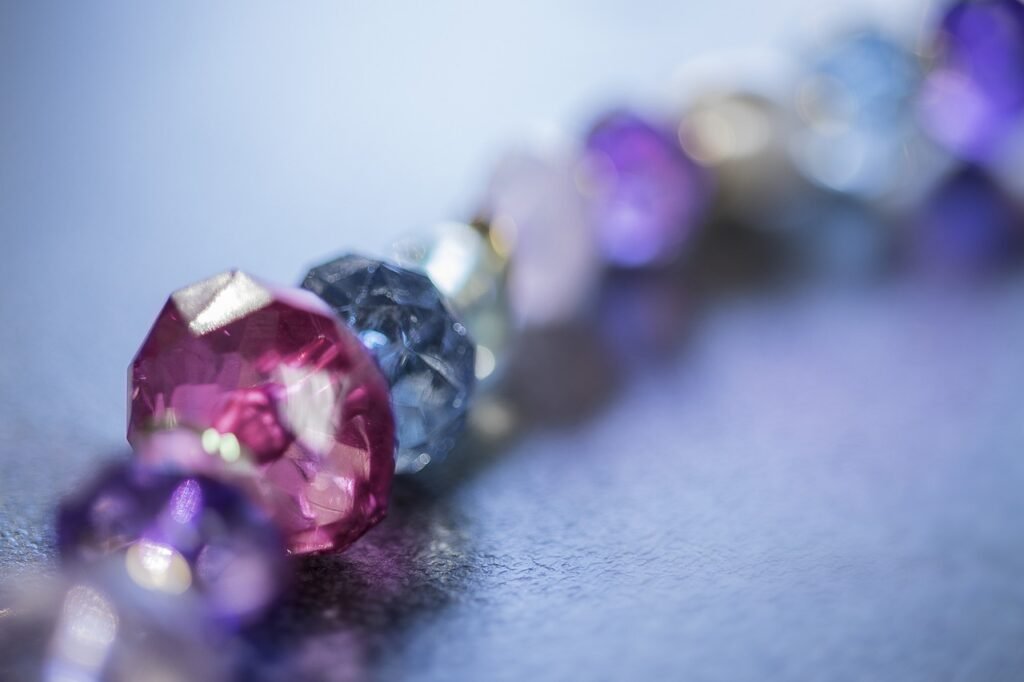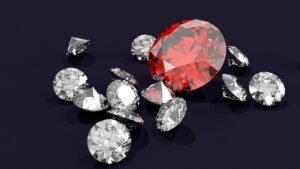
Introduction
The hardest gemstone, the diamond, is highly valued in the fields of gemology and jewelry because of its unparalleled endurance, stunning beauty, and lengthy history.
Characteristics of Diamond
Physical Properties
Diamond is renowned for its unmatched hardness; it is the hardest known natural substance, scoring a 10 on the Mohs scale. The diamond’s remarkable hardness ensures that it will last a lifetime and maintain its brightness while being extremely resistant to wear and scratches. Diamond has extraordinary brightness and fire in
addition to its hardness; it reflects and refracts light to produce a stunning show of hues. This special mix of qualities adds to the diamond’s appeal as a gemstone with unrivaled durability and beauty.
Chemical Composition
Carbon atoms organized in a special crystal lattice arrangement make up the diamond’s core. The diamond’s exceptional optical qualities and durability are attributed to this arrangement, which makes it one of the most sought-after gemstones in the world. The purity and clarity of the carbon lattice play a major role in determining the grade and
worth of a diamond, even if it may include trace elements like nitrogen. The diamond’s chemical makeup not only increases its hardness but also intensifies its fire and brightness, elevating it to the status of a symbol of grace and luxury.
Rarity and Value
The great hardness and brilliance of diamonds, together with their rarity in nature, increase their value in the gemstone market. Compared to other jewels, diamonds are comparatively rare, and fine examples fetch significant prices. Due to their unique mix of durability, beauty, and rarity, diamonds are among the most sought-after gemstones in
the world, valued by investors, jewelry aficionados, and collectors alike. The diamond is a timeless and enduring emblem of luxury and romance since it has been prized as a representation of money, status, and unending love from ancient times to the present.
Geological Formation
Under intense heat and pressure, deep under the Earth’s mantle, diamonds are produced. Diamond crystals are the result of the crystallization and alteration of carbon- bearing minerals over millions of years. After that, volcanic activity brings these
diamonds to the surface of the Earth, where they are found in sedimentary rocks, kimberlite pipes, and alluvial deposits. One of the most valuable and durable treasures
on Earth is created through the intricate and intriguing process of geological production of diamonds, which combines several natural occurrences and geological forces.
Mining Locations
There are several places in the globe where diamonds are mined, including Africa, Australia, Russia, and Canada. These mining sites produce a wide variety of diamond specimens, each with special traits and attributes. Diamond mining is a difficult and labor-intensive operation that calls for cutting-edge knowledge, experience, and
environmental responsibility. The extraction of diamonds, from small-scale miners to large-scale mining operations, is a major contributor to the world economy, sustaining local people in diamond-producing countries and creating job opportunities.
Uses and Applications
Jewelry
There are several places in the globe where diamonds are mined, including Africa, Australia, Russia, and Canada. These mining sites produce a wide variety of diamond
specimens, each with special traits and attributes. Diamond mining is a difficult and labor-intensive operation that calls for cutting-edge knowledge, experience, and environmental responsibility. The extraction of diamonds, from small-scale miners to
large-scale mining operations, is a major contributor to the world economy, sustaining local people in diamond-producing countries and creating job opportunities.
Industrial Applications
Because of their hardness and heat conductivity, diamonds have many industrial uses in addition to their decorative appeal. To precisely machine hard materials like metals, ceramics, and gemstones, diamonds are utilized in cutting tools, grinding wheels, and
drills. Additionally, they find employment in specific applications including electronics, optical components, and heat sinks. Diamond is an essential material in many
industries, including aerospace, automotive, medical, and telecommunications, because of its special qualities. Diamonds have a significant impact on daily items as well as cutting-edge technologies, helping to shape the contemporary world and raise
standards of living.
Identification and Authentication
Gemological Tests
Specialized gemological tests are needed to accurately identify diamonds. These tests evaluate the color, clarity, cut, and carat weight of diamonds. Gemologists assess the
quality and authenticity of diamonds using methods including fluorescence, spectroscopy, and magnification. These examinations assist in establishing the provenance, caliber, and worth of a diamond, guaranteeing that buyers obtain authentic
and superior-grade diamonds.
Certification
A certification from recognized gemological laboratories is necessary to verify the genuineness and caliber of diamonds. Details on a diamond’s color, clarity, cut, and
carat weight are provided in-depth on certificates issued by institutions like the Gemological Institute of America (GIA). Diamond certification verifies the provenance
and quality of the diamond, providing buyers and collectors with peace of mind. Whether buying a diamond as a personal or investment gemstone, certification offers
assurance of the genuineness and worth of the stone.
Famous Diamonds
Notable Examples
A number of well-known diamonds have captivated the attention of people all across the world throughout history. From the Hope Diamond to the Koh-i-Noor Diamond, these fabled stones have fascinating histories and exceptional features that keep both gem
fans and historians enthralled. These well-known jewels’ enticing and mysterious histories are rife with mystery, passion, and adventure. These diamonds serve as
reminders of the timeless allure and attraction of this extraordinary gemstone, whether they are on exhibit in museums or kept in private collections.
Historical Significance
Throughout human history, diamonds have represented power, prosperity, and passion. Since ancient times, people have held diamonds in high regard as representations of power, purity, and eternity. Diamonds have had a profound impact on human culture,
whether they are worn as symbols of love and dedication or as jewelry on royal regalia. Diamonds have been used in crown jewels, religious goods, and ceremonial things
throughout history. They have also been portrayed in literature, art, and mythology. Throughout history, diamonds have been cherished by kings, aristocrats, and lovers; they have transcended time and cultural boundaries to become timeless representations of beauty, love, and unwavering loyalty.
Caring for Diamonds
Cleaning
The beauty and brilliance of diamonds must be preserved with proper care and upkeep. Frequent washing with warm water, light soap, and a soft brush helps the diamond’s surface become free of dirt and debris, allowing it to gleam again. Diamonds may also
be safely and effectively cleaned with steam cleaners and ultrasonic cleaners, but it’s important to take precautions not to subject them to abrasive materials or strong chemicals that could dull or damage their surfaces.
Storage
Diamonds may be kept safe and secure from theft and damage by being stored in a controlled and secure environment. To avoid scratches and abrasions, diamond jewelry should be kept in cushioned jewelry boxes or cloth bags. To reduce the possibility of
damage, it is also essential to store diamonds apart from other jewelry items. To offer an extra layer of protection, it is advised to wrap diamonds in tissue paper or soft
material while transporting or keeping them for lengthy periods of time. Diamond owners may guarantee that their priceless diamonds maintain their beauty and worth for future
generations by adhering to these easy maintenance and storage rules.
Conclusion
To sum up, diamond is the hardest gemstone and is prized for its unmatched toughness, longevity, and beauty. The diamond, which represents riches, rank, and unending love, has enthralled people for generations due to its geological formation and
cultural importance. Diamonds’ eternal heritage and timeless appeal will surely continue to shine brilliant for future generations as long as we continue to admire and adore
them. Diamonds are the epitome of opulence, beauty, and unwavering loyalty, whetherthey are set in a monarch’s crown, glitter in an engagement ring, or pierce the toughest materials on the planet.



